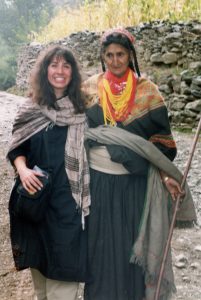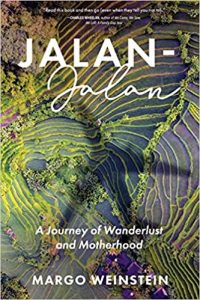Writing A Travel Book During A Worldwide Travel Ban
Writing A Travel Book During A Worldwide Travel Ban
It took a worldwide travel ban and a virtual lockdown for me to finally write my travel book, Jalan-Jalan: A Journey of Wanderlust and Motherhood.

Courtesy of Joani Carpenter, reprinted with permission
I had wanted to write a travel book for as long as I had been traveling, but I never found the block of time I needed. Some authors manage to write in the early morning before their kids wake up and the workday begins or in fifteen-minute breaks throughout the day. But I can’t work that way. To write a book, I needed to focus on writing and nothing else—no travel planning, no vacation travel, no legal work, no work travel, no friends, no extended family, no kids’ sports, no theater, concerts, or parties.
With that limitation, of course, I never found time—until COVID-19 shut the world down, and all I had left to occupy myself was Netflix and a teenager in his room playing video games. After binging Money Heist and The Great British Baking Show, I realized that I could instead use this unwanted time alone (living with a teenager who has a computer in his room is like living alone) to sit down and write my travel book.
After traveling to over eighty countries, I had a lot of stories to tell. But which (if any) of my travels were chapter-worthy? Trips with drama, danger, and humor that involve issues of politics, culture, religion, history, or art would be the best stories and the most interesting to readers. To be substantive enough to drive a chapter, each story needed a narrative arc, and each needed to be different from the other stories, yet also fit into a larger narrative arc for the book. Making the choice harder, because my book would be non-fiction, I could not invent the details I needed to accomplish this. To include a trip, I needed to remember the specifics that would bring the reader along with me.
Here, my legal training came in handy. (I am a lawyer and practiced law for decades before moving to Bali and quitting my job (Chapter 11).) I knew witnesses’ memories could be refreshed with documents or other testimony. I had documents—travel journals, itineraries, background materials, and letters. I also had photos and videos. And I had other testimony—friends and guides who traveled with me and shared the experiences. The trips I chose to feature in Part I were those that fit the criteria above and for which I had a solid basis to refresh my memory.
For example, Chapter Two is about my experience as a teenager climbing Mount Rainier in 1975—forty-seven years ago. I had limited but specific memories of that climb, but I didn’t remember enough to write an interesting chapter in a non-fiction book. Fortunately, the details I needed to bring the experience to life were in a two-hundred-page journal I wrote that summer and saved in a box of mementos. The technical details I needed to describe the climbing route were available online from the National Park Service, US Department of the Interior. Combining these resources, I pounded out a solid first draft, but I still had questions about the veracity of what I wrote.
The company that guided my climb in 1975 still exists, so I called them. A very helpful employee—not busy because guiding had stopped due to the pandemic—confirmed practices and logistics for the climb. She also gave me contact information for a guide from that era. I emailed that guide, and he agreed to review a draft of my chapter about climbing Mount Rainier and answered my biggest question. Did the mountaineering guides really leave exhausted children who could not continue climbing to the summit, alone on the mountain, in the dark, secured in a sleeping bag, staked to a glacier? Yes, they did.
I also had detailed journals for a rafting trip in Northern Pakistan (Chapter One) and a sea kayaking trip in the Tufi region and Trobriand Islands of Papua New Guinea (Chapter Six). In addition, for these trips, I had hours of videotape in an obsolete format I could no longer view. Shopping online from my desk, I bought an old video camera, a used VCR, and a device that converted old formats to digital. Voila! With a little help from the teenager, instead of binging Netflix, I spent days watching my travel videos.
The videos reminded me of great stories I forgot and corrected descriptions I got wrong. (Selected clips from the videos are on my website, www.margoweinstein.com.) Using my memory, supplemented by the journals and videos, I wrote the first drafts of these chapters. I then contacted friends and guides I traveled with and asked them to review the drafts, share their memories of our trips, and offer corrections and comments.
The title I chose for my book, Jalan-Jalan, meant I needed an introduction, the last thing I wrote. Although more than twenty books on Amazon’s US site have Jalan-Jalan in the title, and the phrase is ubiquitous in Bali, where I lived for two years with my son (Chapters 9-12), most Americans don’t know what it means. In the introduction, I explain that, as a verb, jalan-jalan means to take a walk, but also to go on, to go forward, to pass. As a noun, it means road. But jalan-jalan also means (literally and figuratively) a route used for traveling between places, a course taken, and a path chosen in life or career. My book is the story of my jalan-jalan.
The process of writing Jalan-Jalan and creating my website reconnected me with friends, fellow travelers, and guides I had not seen or spoken to in years, sometimes decades. During a time when I could have felt isolated and alone, I renewed relationships with friends in different cities and countries. Like travel, the process of writing Jalan-Jalan connected me to the world.
—
Margo Weinstein is a traveler, intrepid adventurer, class-action lawyer, and single mom. Educated at Yale College and Northwestern University School of Law, she became a partner in a multinational law firm, but that did not stop her from traveling to over eighty countries, moving with her young son to Shanghai and Bali, and discovering how to combine wanderlust and motherhood. For now, she lives with her son in a high-rise in downtown Chicago, anticipating her next move. Jalan-Jalan: A Journey of Wanderlust and Motherhood is her first book.
Find out more about Margo on her website https://margoweinstein.com/
Follow her on Facebook https://www.facebook.com/Margo.Weinstein.Author
—
JALAN-JALAN: A JOURNEY OF WANDERLUST AND MOTHERHOOD
 Can you combine wanderlust and motherhood? Margo Weinstein did.
Can you combine wanderlust and motherhood? Margo Weinstein did.
For decades, Margo Weinstein escaped her demanding legal practice by kayaking, whitewater rafting, trekking, and climbing in remote regions. Then she had a son and found herself in the kiddie pool on a Disney cruise. Searching for a new path, a jalan-jalan, that could accommodate motherhood and satisfy her wanderlust, she dragged her young son to the other side of the world, moving first to Shanghai and then to Bali.
Adventure seekers and armchair travelers will relish reading Weinstein’s exploits as she battles baboons in Zimbabwe and surfaces under a capsized raft in Pakistan. Parents will appreciate her efforts to explore the world with a kid in tow and marvel at her expat life in a villa where a python on the stairs, a scorpion in the outdoor shower, and Hindu offerings ceremonially placed next to the infinity pool and Wi-Fi router are daily realities.
Told with intelligence, humor, spirit, and Weinstein’s version of practicality, Jalan-Jalan will inspire you to find your path and take the trip of a lifetime.
BUY HERE
Category: How To and Tips























